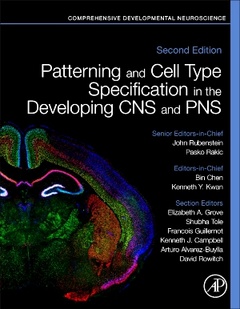Description
Patterning and Cell Type Specification in the Developing CNS and PNS (2nd Ed.)
Comprehensive Developmental Neuroscience
Coordinators: Chen Bin, Kwan Kenneth Y.
Editors-in-Chief: Rubenstein John, Rakic Pasko
Language: English
Subjects for Patterning and Cell Type Specification in the Developing...:
1122 p. · 21.4x27.6 cm · Hardback
Description
/li>Contents
/li>Readership
/li>Biography
/li>Comment
/li>
Patterning and Cell Type Specification in the Developing CNS and PNS, Second Edition, the latest release in the Comprehensive Developmental Neuroscience series, presents recent advances in genetic, molecular and cellular methods that have generated a massive increase in new information. The book provides a much-needed update to underscore the latest research in this rapidly evolving field, with new section editors discussing the technological advances that are enabling the pursuit of new research on brain development. This volume focuses on neural patterning and cell type specification in the developing central and peripheral nervous systems.
I: INDUCTION AND PATTERNING OF THE CNS AND PNS
1. Morphogens, Patterning Centers, and their Mechanisms of Action
Edwin Shinichi Monuki
2. Telencephalon Patterning
Shubha Tole and Jean Hébert
3. Area Patterning of the Mammalian Neocortex
Elizabeth A. Grove
4. Patterning of Thalamus
Guillermina López-Bendito
5. Midbrain Patterning: Polarity Formation of the Tectum, Midbrain Regionalization, and Isthmus Organizer
Harukazu Nakamura
6. Cerebellar Patterning
Hitoshi Komuro
7. Spinal Cord Patterning
Catarina Catela
8. The Formation and Maturation of Neuromuscular Junctions
Gregorio Valdez
9. Neural Induction of Embryonic Stem/Induced Pluripotent Stem Cells
Anindita Sarkar, Maria Carol Marchetto and Fred H. Gage
10. Cerebral organoids
Orly Reiner and Eyal Karzburn
11. Formation of gyri and sulci
Katherine Long and Wieland B. Huttner
II: GENERATION OF NEURONAL DIVERSITY
12. Cell Biology of Neuronal Progenitor Cells
Qin Shen
13. Notch and Neural Development
Joshua J. Breunig
14. bHLH Factors in Neurogenesis and Neuronal Subtype Specification
Jane Johnson
15. The Specification and Generation of Neurons in the Ventral Spinal Cord
Michael Matise and Kamal Sharma
16. Neurogenesis in the Cerebellum
Kathleen J Millen
17. The Generation of Midbrain Dopaminergic Neurons
Sandra Blaess and Siew-Lan Ang
18. Neurogenesis in the Basal Ganglia
Kenneth James Campbell
19. Specification of Cortical Projection Neurons: Transcriptional Mechanisms
Jeffrey D. Macklis
20. The Generation of Cortical Interneurons
Gordon Fishell and Renata Batista-Brito
21. Specification of Retinal Cell Types
Bernadett Bosze, Robert B. Hufnagel and Nadean L. Brown
22. Neurogenesis in the Postnatal VZ-SVZ and the Origin of Interneuron Diversity
Arturo Alvarez-Buylla
23. Neurogenesis in the Damaged Mammalian Brain
Masato Nakafuku
24. Neurogenesis in the Nematode Caenorhabditis elegans
Oliver Hobert
25. Development of the Drosophila melanogaster embryonic CNS: From neuroectoderm to unique neurons and glia
Stefan Thor
26. Neurogenesis in Zebrafish
Laure Bally-Cuif
27. Gene regulatory networks controlling neuronal diversity: epigenetics/lncRNAs/enhancers
Jason T. Lambert, Jessica Haigh and Alex S. Nord
28. Post-transcriptional and translational control of neurogenesis
Debra Silver
29. Human neurogenesis: single cell sequencing and in vitro modeling (cerebral organoids)
Arnold Kriegstein, Aparna Bhaduri and Madeline Andrews
III: DEVELOPMENT OF GLIA, BLOOD VESSELS, CHOROID PLEXUS, IMMUNE CELLS IN THE NERVOUS SYSTEM
30. ‘Glial’ Biology: Has it Come to the Beginning of the End?
David Rowitch and Arturo Alvarez-Buylla
31. Neural Stem Cells Among Glia
Arnold Kriegstein and Arturo Alvarez-Buylla
32. Structure and Function of Myelinated Axons
Matthew Rasband
33. Mechanisms of Astrocyte Development
Debosmita Sardar, Anna Victoria Molofsky and Benjamin Deneen
34. Specification of Macroglia by Transcription Factors: Oligodendrocytes
Michael Wegner
35. Specification of Macroglia by Transcription Factors: Schwann Cells
John Svaren
36. Signaling Pathways that Regulate Glial Development and Early Migration – Oligodendrocytes
Stephen Fancy and Robert H. Miller
37. Signaling Pathways that Regulate Glial Development and Early Migration – Schwann Cells
Kristjan R. Jessen and Rhona Mirsky
38. Microglia
Astrid E. Cardona, Katerina Akassoglou and Dimitrios Davalos
39. Ependymal cells
Kazunobu Sawamoto and Nathalie Spassky
40. Meninges and Vasculature
Julie Siegenthaler and Samuel Pleasure
41. Neuron–Glial Interactions: Neurotransmitter Signaling to Cells of the Oligodendrocyte Lineage
Dwight Bergles
42. Nonmammalian Model Systems: Zebrafish
Bruce Appel and Kelly Monk
43. Astrocyte-Synapse Interactions and Neural Circuit Regulation
Nicola Allen
in Glial Biology: Imaging Neuroglial Pathology In Vivo
Dr. Rakic is currently at the Yale School of Medicine, Department of Neuroscience, where his main research interest is in the development and evolution of the human brain. After obtaining his MD from the University of Belgrade School of Medicine, his research career began in 1962 with a Fulbright Fellowship at Harvard University after which he obtained his graduate degrees in Developmental Biology and Genetics. He held a faculty position at Harvard Medical School for 8 years prior to moving to Yale University, where he founded and served as Chair of the Department of Neurobiology for 37 years, and also founder and director of the Kavli Institute for Neuroscience. In 2015, he returned to work full-time on his research projects, funded by US Public Health Services and various private foundations.
He is well known for his studies of the development and evolution of the brain, in particular his discovery of basic cellular and molecular mechanisms of proliferation and migration of neurons in the cerebral cortex. He was president of the Society for Neuroscience and popularized this field with numerous lectures given in over 35 counties. In 2008, Rakic shared the inaugural Kavli Prize in Neuroscience with Thomas Jessell and Stan Grillner. He is currently the Dorys McConell Duberg Professor of Neuroscience and serves o
- Features leading experts in various subfields as section editors and article authors
- Contains articles that are peer reviewed to ensure accuracy, thoroughness and scholarship
- Covers mechanisms which control regional specification, regulate proliferation of neuronal progenitors, control differentiation and survival of specific neuronal subtypes, and control the development of non-neural cells




